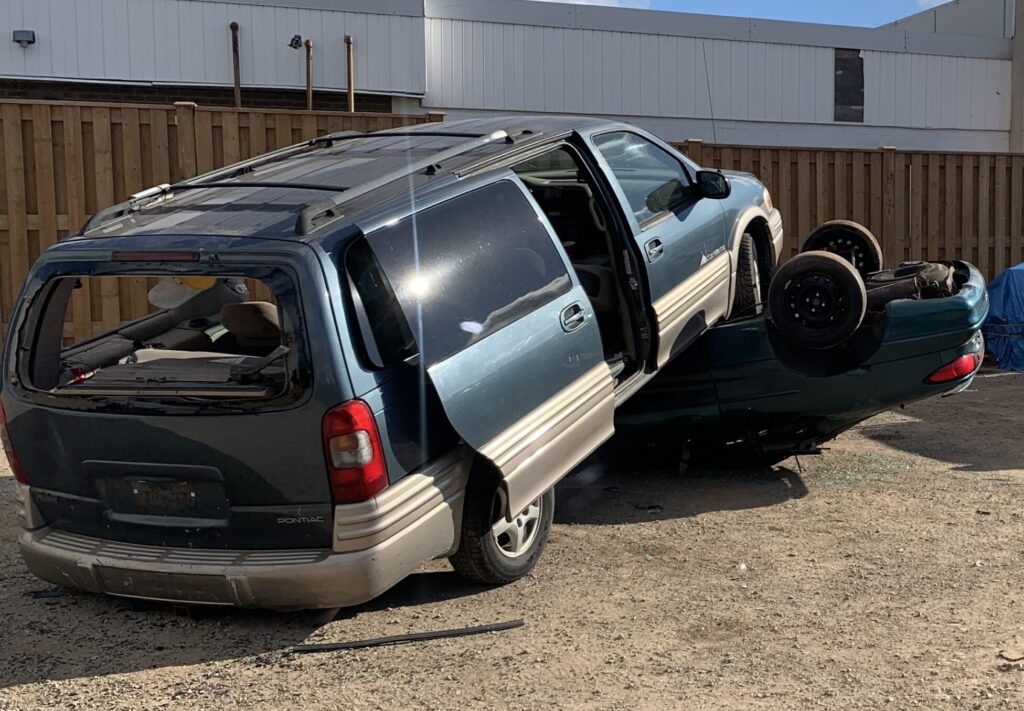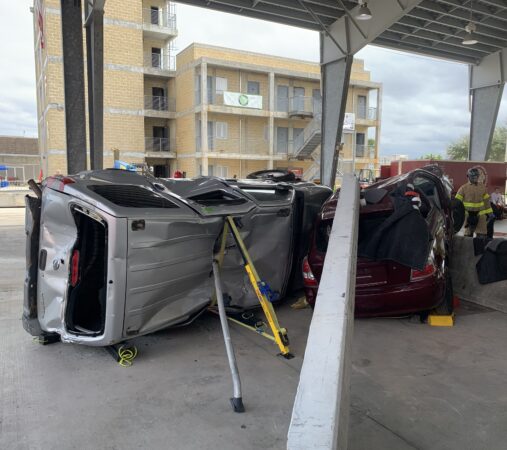
Extrication Tips: Recon in the rescue environment
By Chad Roberts
Features Extrication canadian firefighter editors pick firefighter training training Photo credit: Chad Roberts
Photo credit: Chad Roberts All too often we get caught up with the skills that relate to specific types of rescues. We see this not only in training but also in how we operate on scene. It’s easy to get caught up in the tools and techniques that engage all of us so much in the world of technical rescue. This can range from being trained on a skill before learning the basics, to on scene operations who skip tasks that can endanger our members and patients, and cause us to miss critical information that will make our jobs much easier. What I’m specifically referring to is the reconnaissance step that we must be well versed in at all of our rescue scenes in order to provide the safest and most efficient outcomes for everyone.
In our respective fire services, we are taught to do things and think critically at a high pace to ultimately battle our enemy: time. While this is still as important as it has always been, the recon in the rescue environment needs to be calculated slightly different. The ever solicited “take a minute to make a minute” or “slow down and breathe” phrases hold a lot more weight at our rescue calls. The complexities involved and resources required to mitigate these scenes require the first on scene officers and firefighters alike to take the extra time to properly size up their environment and avoid missing the critical information.
While there are many different technical rescue disciplines that your department may require you to perform, I am going to take a more specific look at the auto extrication scene. That being said, the steps I am about to describe are by no means specific only to the extrication world. These can be modified quite simply to fit the needs for almost any tech rescue scene. Please feel free to change and make it work in your department as you see fit.
A proper 360 will provide you not only the number of patients but their orientation in the vehicles.
Advertisement
To start, we’re looking at the information that the first on scene member should be gathering while performing a full 360 view of the scene. The 360 is such an important factor in all our scenes, and in these specific situations it should be done immediately after you exit the apparatus while the remaining members of your crew are gathering the equipment they may need. Ideally, this total scene view should be accomplished before any other crew members touch or approach the specific vehicles involved. While performing this walk around you must be sure to look for, and make note of, the following:
- Immediate safety hazards.
- Number of vehicles involved in the incident.
- Types of vehicles that are involved.
- Number of patients involved in the incident.
Our immediate safety hazards may seem straightforward: glass, gas, fire, wires. While all of those do stand true, what about the most glaring safety issue—traffic and scene protection. Although it sounds like a no brainer, far too often we are seeing firefighters and first responders alike being injured or killed on roadways across North America because we fail to secure our scene before we exit the apparatus. Proper “fend off” positioning, extra lane closure and spacing from the incident need to be addressed in order for our crew members to exit the apparatus safely, let alone approach the scene.
Next is trying to identify the number of vehicles involved. While this may be simple to accomplish from the front seat as you’re rolling up on scene, it may be more difficult than it appears. Night, weather and terrain conditions can severely hamper our initial impressions of how many vehicles are involved. We must stay diligent and perform that 360 survey with our head on a swivel to look out for and recognize other vehicles that may have left the roadway, were trapped under another larger vehicle, or maybe left the scene altogether. Sometimes out of confusion, these unknown vehicles involved may just be further up the road where you may need to direct additional resources. By properly identifying the correct number of vehicles involved in our scenes we will be able to get an early indication of how many additional resources we may need before we move on to our next step.

Early recognition of hazards including light standards and posts can prevent further complications and injuries. Photo credit: Chad Roberts
Just as important as the number of vehicles involved is the type of vehicle. While many accidents we respond to involve passenger vehicles, we must keep in mind all the other vehicles occupying space on our roadways. Transport trucks, dump trucks, school busses, oversized loads and motorcycles are just the tip of the iceberg. A lot of this may be specific to your responding districts, but the one thing that remains common for us all is that we need to identify “what” the vehicle is carrying (cargo/people), and how it is “powered”. Being able to identify what is inside the vehicle will quickly help you identify whether this is a scene where you will be addressing mainly patient injuries and require EMS assistance, or whether you might have a full-blown hazmat situation that is going to require specialized rescue teams. Don’t ever rule out heavy vehicles involved; once it is confirmed that a large vehicle is involved, be sure to start thinking about contacting heavy tow operators and your specialized heavy rescue teams. The more recent, but not so recent, hazard of what is powering these vehicles cannot be overstated. By figuring out early on in your 360 if you have an alternatively fuelled vehicle (EV, hybrid, propane, NG), you’ll be able to start formulating alternative plans for extrication, fire control, or even who to call to help assist you with shut down and towing procedures.
And lastly, the most important aspect of our 360 recon is the number of patients we have involved in our scene. Even though this may seem simple, this bit of information may be difficult to pinpoint. These patients may be in the vehicles involved, but more regularly now can be in any number of places. They can be seen walking outside the vehicle (unsafely in open traffic lanes), running away, under other vehicles or nowhere to be found. Be diligent with this step; don’t take what you see as truth right away. Talk with witnesses and look for other clues, such as car seats and other seat belts that have the seat belt pretensioner applied and loose that no one is sitting in, to give you some better ideas. The use of a thermal imager can also be a great tool to not only check the seats for other occupants’ warmth, but a quick scan around the vehicle may also provide you with patients that have left the scene. Once all patients are accounted for, the last part of this step is to identify their orientation in/or around the vehicle. This will provide you with the most pivotal information that will start to formulate your extrication plan. By knowing their orientation, be it sitting, upside down or underneath another object and pinned, things will work largely in your favour as to figuring out your next steps of how to manage your extrication scene quickly, safely and efficiently.
Chad Roberts is a firefighter in Oakville, Ont. He is a member of the Oakville extrication team and competes and trains across North America. Contact Chad at chadroberts12@gmail.com.
Print this page
Advertisement
- Latest stats show Saskatoon Fire Department no longer just about battling blazes
- The C-word: firefighters push for better cancer protection